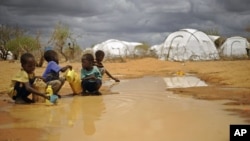The World’s biggest refugee camp, Dadaab, in northeastern Kenya marks its 20th anniversary this year. The camp, which was set up to host 90,000 people, now shelters nearly one-half million refugees.
This United Nations refugee agency (UNHCR) video presents a collage of photos and archive footage of Dadaab over the past 20 years. Early images of cadaverous people are repeated over the two decades in which Somalis have been fleeing war, drought and famine in their country.
The UNHCR set up the first camps in Dadaab between October 1991 and June 1992, following a civil war that continues to this day. UNHCR spokesman, Andrei Mahecic, said the 20th anniversary of the Dadaab refugee camp is nothing to celebrate.
“It is just a tragic reminder of the 20 long years of misery and displacement for Somali people… that Dadaab has been able to provide refuge for so many years and to so many people, it is principally thanks to the people and the government of Kenya," said Mahecic. "UNHCR, together with the government and working with other agencies, has provided protection, shelter and humanitarian assistance, often under difficult and complex circumstances-chronic overcrowding, risk of disease and seasonal floods are among these challenges.”
Weathering storms
The Dadaab refugee complex came under particular strain during last year’s famine in Somalia. The UNHCR says more than 100,000 Somalis fled to the camp in Kenya between June and August.
Providing humanitarian assistance for 463,000 refugees is a constant struggle. This is being made more difficult by the increasing dangers in the camp. Three aid workers were kidnapped in the autumn. More recently, two refugee leaders and several Kenyan police were killed.
In addition, threats against humanitarian workers are hampering the provision of aid. Life-saving assistance such as the provision of food, water and health care goes on. Growing insecurity in the refugee complex, though, is hindering the delivery of vital relief supplies and forcing other activities to be scaled back.
Stabilizing Somalia
UNHCR spokesman Mahecic said a strong international initiative to bring peace and stability to Somalia is the only solution to the ongoing refugee and displacement crisis.
“Without that there will be very little possible in terms of finding the humanitarian answers and the solutions for these people who have been displaced. We are talking about one million refugees outside Somalia. We are talking about… nearly 4 million Somalis displaced inside the country. This is pretty much every fourth Somali is not living in his or her home,” said Mahecic.
A high-level international conference on Somalia is due to start in London on Thursday. The UNHCR says it hopes the meeting, which will be attended by 40 world leaders, will act as a catalyst for a permanent solution to one of the world’s most enduring and critical situations.
It says an end to the violence in Somalia would create the possibility for millions of refugees and displaced persons to return home.











